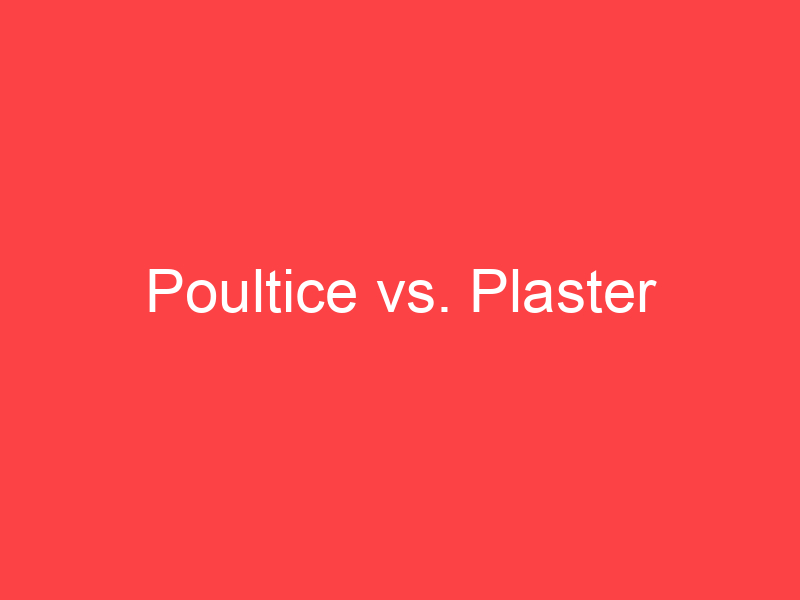Main Difference
The main difference between Poultice and Plaster is that the Poultice is a soft moist mass, often heated and medicated, that is spread on cloth over the skin and Plaster is a general term for a broad range of building and sculpture materials
-
Poultice
A poultice, also called a cataplasm, is a soft moist mass, often heated and medicated, that is spread on cloth and placed over the skin to treat an aching, inflamed or painful part of the body. It can be used on wounds such as cuts.
‘Poultice’ may also refer to a porous solid filled with solvent used to remove stains from porous stone such as marble or granite.
The word “poultice” comes from the Greek word “poltos” transformed in the Latin puls, pultes, meaning “porridge”.
-
Plaster
Plaster is a building material used for the protective or decorative coating of walls and ceilings and for moulding and casting decorative elements.
In English “plaster” usually means a material used for the interiors of buildings, while “render” commonly refers to external applications. Another imprecise term used for the material is stucco, which is also often used for plasterwork that is worked in some way to produce relief decoration, rather than flat surfaces.
The most common types of plaster mainly contain either gypsum, lime, or cement, but all work in a similar way. The plaster is manufactured as a dry powder and is mixed with water to form a stiff but workable paste immediately before it is applied to the surface. The reaction with water liberates heat through crystallization and the hydrated plaster then hardens.
Plaster can be relatively easily worked with metal tools or even sandpaper, and can be moulded, either on site or to make pre-formed sections in advance, which are put in place with adhesive. Plaster is not a strong material; it is suitable for finishing, rather than load-bearing, and when thickly applied for decoration may require a hidden supporting framework, usually in metal.
Forms of plaster have several other uses. In medicine plaster orthopedic casts are still often used for supporting set broken bones. In dentistry plaster is used to make dental impressions. Various types of models and moulds are made with plaster. In art, lime plaster is the traditional matrix for fresco painting; the pigments are applied to a thin wet top layer of plaster and fuse with it so that the painting is actually in coloured plaster. In the ancient world, as well as the sort of ornamental designs in plaster relief that are still used, plaster was also widely used to create large figurative reliefs for walls, though few of these have survived.
-
Poultice (noun)
A soft, moist mass applied topically to a sore, aching or lesioned part of the body to soothe. A poultice is usually wrapped in cloth and often warmed before being applied.
-
Poultice (verb)
To treat with a poultice.
-
Plaster (noun)
A paste applied to the skin for healing or cosmetic purposes.
-
Plaster (noun)
A small adhesive bandage to cover a minor wound; a sticking plaster.
-
Plaster (noun)
A mixture of lime or gypsum, sand, and water, sometimes with the addition of fibres, that hardens to a smooth solid and is used for coating walls and ceilings; render, stucco.
-
Plaster (noun)
A cast made of plaster of Paris and gauze; plaster cast.
-
Plaster (noun)
plaster of Paris.
-
Plaster (verb)
To cover or coat something with plaster; to render.
“to plaster a wall”
-
Plaster (verb)
To apply a plaster to.
“to plaster a wound”
-
Plaster (verb)
To smear with some viscous or liquid substance.
“Her face was plastered with mud.”
-
Plaster (verb)
To hide or cover up, as if with plaster; to cover thickly.
“The radio station plastered the buses and trains with its advertisement.”
-
Plaster (verb)
To smooth over.

